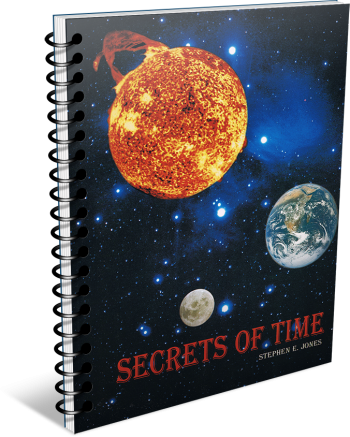Latest Posts
View the latest posts in an easy-to-read list format, with filtering options.

The revelation of timing as revealed in the Scriptures and in history. It reveals the importance of October 1986 as the 120th Jubilee from Adam and the legal declaration of the Jubilee in the fall of 1986. The book shows the order in history and how nothing happens by accident. It reveals "the time of Jacob's trouble" and how America, Canada, Britain, and other nations fit into the overall Plan of God.
Category - General

The Creation New Year in ancient times began in September when they sighted the first crescent moon in the western sky at sunset. Thus, the calendar in Mesopotamia, the area from which Abram emigrated, began each new year in the fall of the year.
The Egyptian calendar, on the other hand, began its new year in the spring. It is interesting to see that when God was ready to lead Israel out of Egypt, He told Moses that the Passover month (Abib) was to be reckoned as their first month (Ex. 12:2). From then on, Israel numbered its months from the first crescent moon in the spring of the year. Nonetheless, their sabbath years and Jubilees were proclaimed in the fall of the year on the tenth day of the seventh month (i.e., September/October). This was a practical necessity, seeing as how it was the end of the growing season.
The people planted their cereal crops in the fall and allowed them to grow during the winter months. If Israel had proclaimed the land-rest years to begin in the spring, the people would not have been allowed to harvest their barley or wheat which was ripening at that time. Thus, to proclaim a rest year in the spring would have prevented them from harvesting that spring and from sowing the next fall, which would have still fallen within the year-long ban on sowing or reaping. Thus, they would have had no crops for two years out of seven.
Consequently, we see that Israel’s calendar followed a dual pattern. The months were numbered beginning in the spring, when their feast-day calendar of events began; however, their agricultural years (sabbath years) always began in the fall after the people had harvested all the fruits of the land—particularly the grapes, which ripened in the fall.
As we said above, the priests calculated the beginning of each month by the first visible sliver of the moon on the horizon that appears at sunset shortly after a couple of days of no moon. When they saw this, they knew to blow the trumpet to signal that this was the first day of the next month. The seventh such moon was a special day called the Feast of Trumpets. It was the seventh trumpet of the book of Revelation (Rev. 10:7), and “the last trump” in Paul’s writings, which signifies the great day of Resurrection (1 Cor. 15:52). The feast days, of course, contain the main biblical revelation regarding the times and seasons of Christ’s first and second work on earth.
The Hebrew word for “month” is the same word translated “moon." This is because a Hebrew month was a lunar cycle from the first crescent to the first crescent. It was very practical for the people in those days, many of whom wandered throughout the wilderness shepherding their sheep to find pasture. No matter where they were, they always had their calendar painted in the night sky and would soon be experts at knowing precisely which day of the month it was at any given time.
However, 12 lunar months only came to 354 days in the year. It was about 11 days short of a solar year. If they had simply declared the new year every 12 months, it would not have been long before Passover would have been in February or October. Worse yet, their sabbath years would also have begun 11 days earlier every year as well, and this would have caused havoc in their agriculture. This was also a problem among the other nations who used a lunar calendar. The problem was solved everywhere by the addition of a 13th month every few years, delaying the beginning of the next year by a whole month.
In 1995, Passover fell on April 15, which was also the 15th day of the lunar month. Passover always occurs on a full moon, in the middle of the lunar month. But in 1996, Passover fell on April 4. If this retrograde were allowed to continue, then in 1997, Passover would arrive on March 24, and in 1998, it might be celebrated on March 13. To solve this problem, the Hebrews would add an extra lunar month in the previous year to push Passover into the next month. Then, instead of retrograding 11 days, it would go ahead 19 days (i.e., ahead 30 days for the month, minus 11 days for the normal retrograde).
This is why each year Passover and the Wave-Sheaf Offering (i.e., “Easter Sunday”) always appear to fall on different days.
The question is, how did the priests know when to call for a 13th month to reset the new year a month later? They did this by checking the barley harvest each spring. When they came to the end of 12 lunar months, they had to determine if the next month was to be the 13th month of the previous year, or the first month of the next year. So they went into the field and gathered some barley to see if it was “eared out.” That is, they checked to see if the outer covering (chaff) had opened up to expose the grain of life itself. If so, then they knew that they would be able to wave the firstfruits sheaf on the Wave-Sheaf Offering.
If it was still too early for ripened barley, they would have no firstfruits to offer God on the Wave-Sheaf Offering. Hence, they would call for a 13th month that year. After giving the barley one more month to ripen, they would certainly have ripe barley for the firstfruits offering. And so, the first month in the spring was determined overall by the lunar cycle, but the timing ultimately focused upon the ripening of the barley.
This was very important, because the Wave-Sheaf Offering of barley signified the Resurrection that followed Passover (death). In the types and shadows of the Old Testament, Passover prophesied of Jesus’ death on the Cross, while the Wave-Sheaf Offering of barley prophesied of Jesus’ Resurrection. The people could not keep Passover without a corresponding Wave-Sheaf Offering that signified Resurrection. Otherwise, the type would be broken, and it would no longer truly prophesy of Jesus’ work. It was thus important that the barley be eared out, that the chaff (body) be broken, and that the life of the grain come forth, for this pictured Resurrection from the dead.